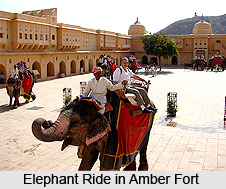 Amber is one of the legendary cities of Rajasthan. Founded by the Meena Ruler Alan Singh this ancient city flourished during 967AD which was later on conquered by the Kachwaha clan of Rajputs. Presently the existence of this legendary state is marked by the magnificent Amber Fort which stands as the last replica of once a flourishing city. The old city of Amber which was later on replaced by the new city of Jaipur that was built at a distance of 9 kms south of Amber. Along with its famous Amber palace the city of Amber was also protected by the Jaigard fort which was built for the military purpose only. With its strategic location it was the biggest saviour of Amber city.
Amber is one of the legendary cities of Rajasthan. Founded by the Meena Ruler Alan Singh this ancient city flourished during 967AD which was later on conquered by the Kachwaha clan of Rajputs. Presently the existence of this legendary state is marked by the magnificent Amber Fort which stands as the last replica of once a flourishing city. The old city of Amber which was later on replaced by the new city of Jaipur that was built at a distance of 9 kms south of Amber. Along with its famous Amber palace the city of Amber was also protected by the Jaigard fort which was built for the military purpose only. With its strategic location it was the biggest saviour of Amber city.
 Amber was one of the picturesque cities located at the hilly mountain region surrounded with picturesque lakes. This city was originally ruled by the Meena tribe during 967 AD. This old city had to undergo a lot of attacks. The most well known was its clash with the Kachwas clan of the Rajputs who saw to bring a complete end of the city. According to local legends the first ruler of Amber Meena Raja Alan Singh who is also known as Alan Singh Chanda of Khogong , adopted a child and his mother who came under his refuge. Later on he sent this little child Dhola Rae to Delhi to represent his kingdom of Amber. On return of the gratitude shown by the Meena ruler the Rajputs sent traitors and conspirators who killed the little successor of Meena dynasty when he was performing the ritual of Pitri Tarpan. As per custom s the little prince was weapon less during the ritual which was utilised by the Rajputs who killed the young child in disguise. In this manner they captured the Khogons and subjugated Shira Gotra of the Meenas which was later on known as Jamwa Ramgadh near Jaipur. The conquest between the Rajputs and the Menas was one of the fiercest battles of Rajasthan which ended up by floating thousands of bodies of the Meena tribal people in the lake that surrounded the Amber palace. After capturing the city of Amber the Rajputs changed it as their capital. Slowly and steadily the Rajputs captured rest of districts which surrounded the main city of Amber.
Amber was one of the picturesque cities located at the hilly mountain region surrounded with picturesque lakes. This city was originally ruled by the Meena tribe during 967 AD. This old city had to undergo a lot of attacks. The most well known was its clash with the Kachwas clan of the Rajputs who saw to bring a complete end of the city. According to local legends the first ruler of Amber Meena Raja Alan Singh who is also known as Alan Singh Chanda of Khogong , adopted a child and his mother who came under his refuge. Later on he sent this little child Dhola Rae to Delhi to represent his kingdom of Amber. On return of the gratitude shown by the Meena ruler the Rajputs sent traitors and conspirators who killed the little successor of Meena dynasty when he was performing the ritual of Pitri Tarpan. As per custom s the little prince was weapon less during the ritual which was utilised by the Rajputs who killed the young child in disguise. In this manner they captured the Khogons and subjugated Shira Gotra of the Meenas which was later on known as Jamwa Ramgadh near Jaipur. The conquest between the Rajputs and the Menas was one of the fiercest battles of Rajasthan which ended up by floating thousands of bodies of the Meena tribal people in the lake that surrounded the Amber palace. After capturing the city of Amber the Rajputs changed it as their capital. Slowly and steadily the Rajputs captured rest of districts which surrounded the main city of Amber.
Amber city was then replaced by the new city of Jaipur which was built by Sawai Jai Singh II at a distance of 9 kilometres from Amber. In this new city all the prominent buildings and houses of prominent people were shifted. However, the old capital continued to retain the temple of Shila Devi which used to be worshipped by a small clan of Bengali priests. They continued to remain in their original place while the connecting fort called Jaigarh fort also maintained its old stature. Overall these were the oldest cities of Rajasthan.
Thus marked by the glorious palace of Amber this historic city has been presently changed some popular market place and cafeterias which attract the tourists. While the fort retains its original glory, the city has been disintegrated into the township of Jaipur which grew slowly and gradually.



















